Surprising fact: fall shoulder season can cut crowds by over 40% and lower prices while festivals and harvest events pulse across the continent.
I write as someone who prefers quieter mornings and richer local flavor on every trip. I pick iconic european cities and a few under-the-radar gems so you get a practical, joy-filled list without wasting time or budget.
I balance big museums and castles with strollable neighborhoods, riverside cafés, and photo-ready corners you can actually enjoy. Think Paris’s museum magic, Florence’s Renaissance streets, Venice at dawn, and Granada’s Alhambra at golden hour.
My focus is simple: how long I stay, what I prioritize, and small moves that stretch your dollars and your days. I’ll point out markets, parks, and the exact windows for golden-hour shots so your trip feels authentic and relaxed.
Key Takeaways
- Shoulder season offers fewer crowds and better prices.
- I blend top museums with walkable neighborhoods for real-life enjoyment.
- Festivals and harvest events add local color to fall travel.
- Practical tips on timing and priorities make trips stretch further.
- Included are photo spots, markets, and calm mornings for authentic moments.
How I chose this list: cities, towns, vibes, and real time on the ground
I picked each entry because I’ve spent full days there—walking streets, testing transit, and sitting in neighborhood cafés. That direct time lets me judge how a city or small town feels beyond photos and guidebook blurbs.
I favor places with clear anchors—a museum, riverfront, market, or castle—plus compact centers where people linger in parks and cafes. Walkability and reliable transit weigh heavily; they make exploring effortless and let you skip renting a car.
Crowds matter. I note where tourists cluster and when mornings or shoulder season offer calm. Region by region, I weigh whether a stop works as a base, a deep-dive, or a quick detour.
- Mix of lively city stops and quieter towns for balance.
- Practical focus on access, atmosphere, and value.
- Seasonality and timing tips so you find pockets of calm.
The best places to visit in Europe: iconic cities I’d return to again and again
![]()
Some cities keep pulling me back, each time offering a new detail I hadn’t noticed before. I pick stops that mix landmark moments with daily routines: museum sprints, slow café breaks, and quiet walks at dawn or night.
Paris, France: architecture, museums, and that slow-down-and-savor-the-cafe-life energy
Paris is instant joy for me. I move between Musée d’Orsay and Musée de l’Orangerie, then wander toward Notre-Dame as it reopens. Small squares and a sunny cafe seat make the city breathe.
Florence, Italy: Renaissance streets, the Duomo, and views from Piazzale Michelangelo
Florence is dense with history and craft. The Duomo, Uffizi, and Accademia demand short, focused visits so you can cross the Arno to the Oltrarno and soak up artisan life. I could spend days just walking here.
Venice, Italy: early-morning canals, quiet lanes, and off-season magic
Venice rewards early risers. At dawn San Marco feels fresh and local boats make their rounds. I love hunting out Libreria Acqua Alta and returning at blue hour for quiet bridge photos.
- I balance must-see highlights with small routines: morning walks, mid-day museum sprints, and lingering evenings.
- Food and cafe moments anchor each day; simple menus and good wine turn quick stops into memories.
Charming smaller cities and towns with big history (and great wine)
https://www.youtube.com/watch?v=UDp9Mut8Ey0
I find that compact towns often serve up big moments alongside quiet streets and good wine. These cities offer dramatic monuments without the long lines. They feel lived-in and rarely demand more than a day or two to enjoy.
Verona, Italy: Roman Arena nights, lively piazze, and day trips in the Veneto
Verona thrills when the Arena lights for opera or concerts. I drift from Piazza Bra to Piazza dei Signori and hide in Giardino Giusti for a calm hour. Torre dei Lamberti and San Zeno give the city its big-history frame, while a glass of local wine closes the day nicely.
Vicenza, Italy: Palladian architecture, locals on bikes, fewer tourists
Vicenza feels quieter than Venice. The Loggia del Capitanio and Palladian villas line a compact center where locals ride bikes and chat in piazzas. It’s a bit under the radar, which means fewer tourists and more ordinary life to watch.
York, England: walkable walls, the Minster, and hours well spent in the Shambles
York is textbook charm. I walk the medieval walls, visit York Minster, and wander the Shambles. Museum Gardens and the National Railway Museum add variety. I often save an evening for Evensong or a pint in a tucked-away pub.
- All three blend big history with a welcoming, manageable scale.
- They make great bases for easy day trips around their region.
- I favor walking more than waiting and these cities encourage that rhythm.
| City | Top Sites | Why I Like It | Suggested Stay |
|---|---|---|---|
| Verona | Arena, Torre dei Lamberti, Giardino Giusti | Roman flair, lively piazze, opera nights | 1–2 days |
| Vicenza | Loggia del Capitanio, Palladian villas, compact old town | Calmer Veneto vibe, architectural focus, locals on bikes | 1 day |
| York | York Minster, city walls, the Shambles, Museum Gardens | Medieval streets, museum choice, cozy pubs | 1–2 days |
Sun, tiles, and tapas: southern European cities that stole my heart
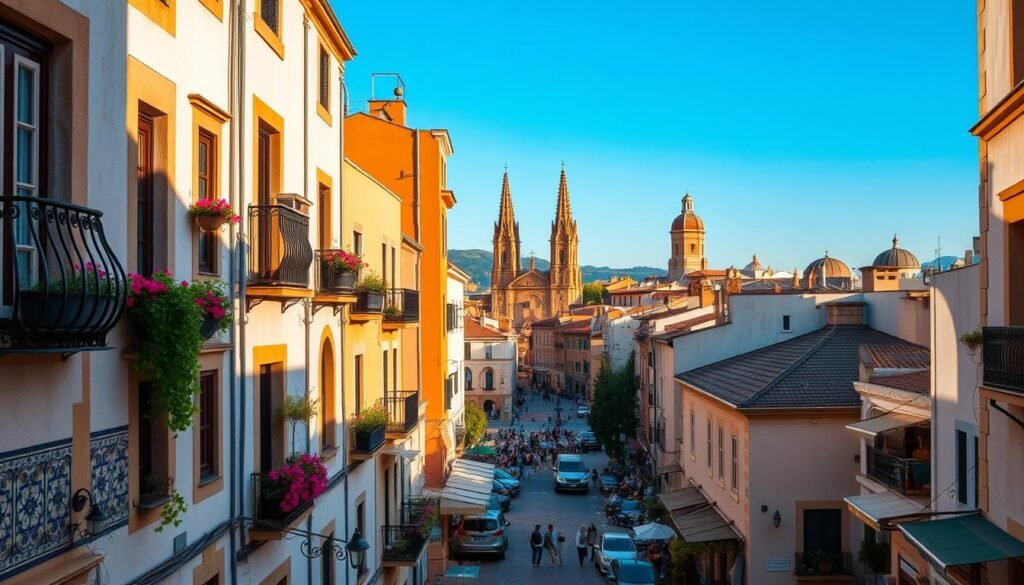
Southern sunlight, tiled courtyards, and late-night tapas shaped my fondest memories. These cities mix layered history with lively streets and tiny dishes meant for sharing. I travel with a slow rhythm: mornings for quiet wandering, afternoons for rest, and evenings for food and light.
Granada, Spain: the Alhambra, Generalife Gardens, and golden-hour strolls
The Alhambra and Generalife are UNESCO-listed, and I plan my day around them. After the palaces I stroll the Carrera del Darro and climb into the Albayzín, where Moorish history meets mountain views.
I build in sunset time—golden light on white roofs makes photos effortless and the city feel almost cinematic.
Seville, Spain: the Alcázar, the Giralda’s views, and evenings in beautiful plazas
The Alcázar’s courtyards blend Moorish and Christian detail, and the Giralda gives easy panoramic views. Plaza de España is a tile lover’s dream; the Catedral de Sevilla impresses with its soaring scale.
I highly recommend booking major sights ahead and then padding the schedule with cafe stops and late dinners. Tapas and regional food let me sample more without rushing, and even in summer I favor mornings and nights for wandering.
- I often leave with a list of things I didn’t fit in—proof I’ll return.
- If you love architecture and atmosphere more than checklists, these european cities are a perfect place to linger for a few days and really visit.
Culture-rich capitals with local vibes (easy to explore in a day or three)
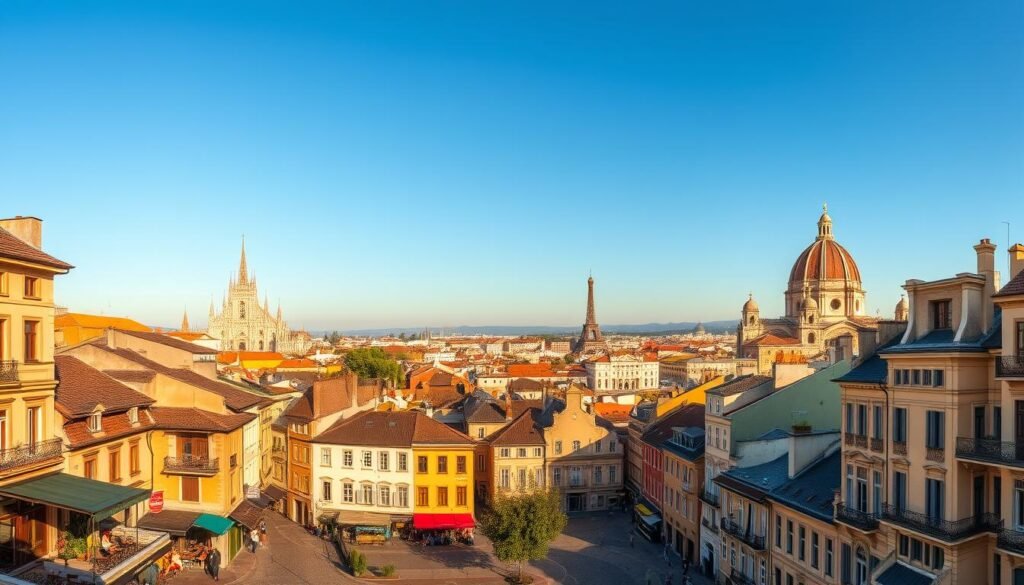
I pick capitals that feel lived-in, where museums sit beside daily markets and a good coffee is never far away. These cities give you big sights without marathon days, and they reward slow loops through neighborhoods.
Dublin greets me with Trinity College—think the Book of Kells and the Long Room—then a short walk through St Stephen’s Green and along Grafton Street. A quick stop at City Hall or Dublin Castle adds context. I like to join a walking tour early, then end the evening in a pub where live music and people-watching stretch the night.
Dublin, Ireland
Highlights: Trinity College, St Stephen’s Green, Grafton Street, Dublin Castle.
Ljubljana, Slovenia
Ljubljana’s charm is its scale: castle above, river below, and a Central Market where locals shop. I snack my way between stalls, sit by the water with a coffee, then wander the cafe-lined streets. With things packed compactly, you can enjoy the core in a day or two and still relax.
Edinburgh, Scotland
Edinburgh pairs a dramatic castle and the Royal Mile with green escape—Arthur’s Seat and Dean Village. I schedule the castle visit first, then lace up for a hike and finish with a whisky tasting or a cozy cafe stop in Grassmarket. In cooler months, museums and indoor tours make the city just as friendly.
- Why these cities work: strong core sights, walkable centers, and real local life.
- I sequence big-ticket stops early, then let neighborhoods and tips shape the rest of the day.
- For more underrated capitals I love, see underrated capitals.
| City | Core Sights | Quick Stay Tip |
|---|---|---|
| Dublin | Trinity College, St Stephen’s Green, Dublin Castle | Do a morning tour, then pub evening with live music |
| Ljubljana | Hilltop castle, Central Market, riverside cafes | Snack market stalls, relax by the river for photos |
| Edinburgh | Edinburgh Castle, Royal Mile, Arthur’s Seat, Dean Village | Castle early, hike midday, whisky or museum later |
Fairytale charm and wine country: cross-border flavors you’ll definitely love
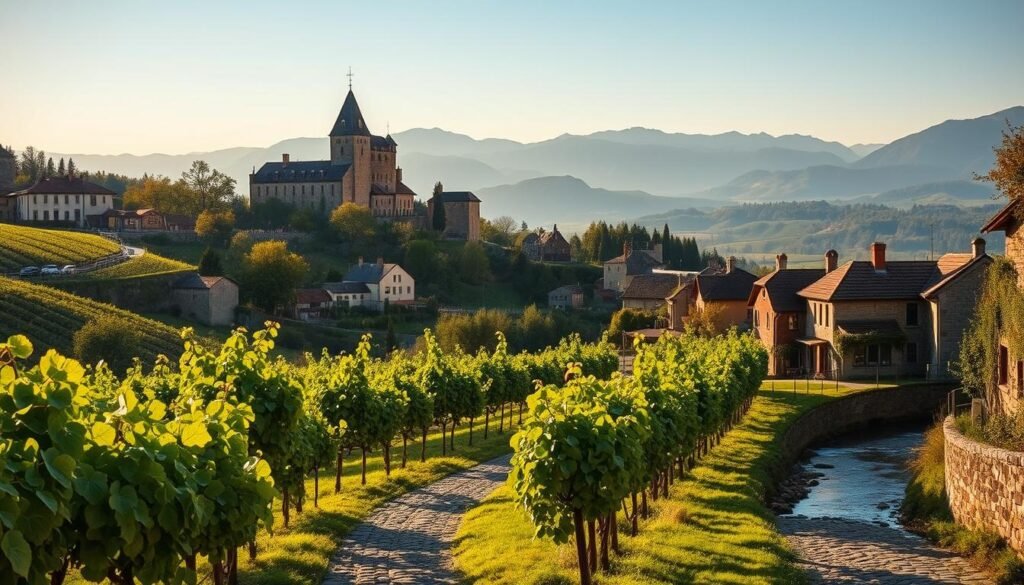
For a mix of polished monuments and relaxed coastal rhythm, I stitch Strasbourg and Normandy into one easy chapter of a trip.
Strasbourg sits where France and Germany meet. The cathedral towers over narrow lanes and the canal-side quartier feels like a storybook. I plan time for small winstubs and Alsatian plates, and I always taste local wine while drifting between boutiques and squares.
Normandy offers a different pace. I often jump a ferry from Calais, then take a short road loop for bakeries, cliff views, and sleepy harbors. Fresh pastries in the morning, sweeping beaches by afternoon, and a cozy inn at night make this region a true reset.
- Strasbourg: one to two days for cathedral, canals, and tasting Alsatian cuisine.
- Normandy: a relaxed road trip for coastal scenery, village bakeries, and markets.
- Both offer cross-border flavor with low fuss and rich rewards.
| Place | Highlights | Suggested days |
|---|---|---|
| Strasbourg (city) | Cathedral, Petite France, Alsatian wine | 1–2 days |
| Normandy (region) | Cliffs, bakeries, coastal roads | 2–4 days |
| Combined | Easy logistics, varied scenery, ideal for a short trip | 3–6 days |
Hidden gems and unique places for your second (or third) visit
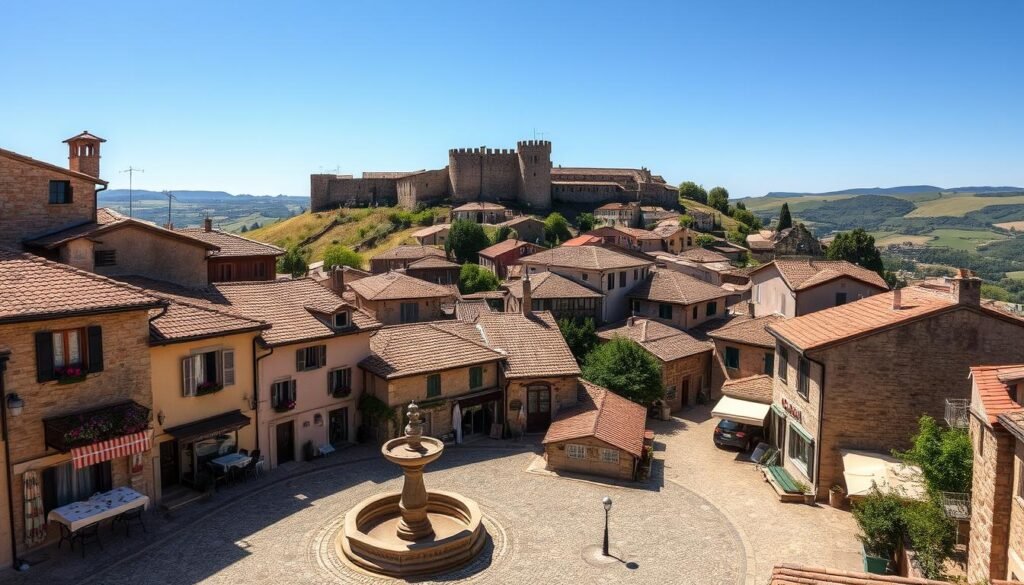
For a second or third trip, I chase corners where locals still set the pace and the map loosens its grip. These regions trade postcard lines for market mornings, coastal roads, and mountain trains that slow you down.
Belgrade, Serbia: The city straddles old and new along the Sava. I wander daily markets by day and settle into kafanas for late-night music.
Kaszuby, Poland: Also called Kashubia, this lake-rich region has 700 lakes and quiet forests. Locals speak Kashubian; I paddle, hike, and truly unplug there.
The Albanian Coast: This is definitely one for adventure. I plan an open-top jeep road trip from Tirana through Vlöre, Llogara, Dhërmi, and historic Berat and Gjirokastër.
Calabria, Italy: Three national parks, seaside towns, and slow-travel food make summer coastal days gentle and uncrowded.
Bad Gastein, Austria: About 1.5 hours by train from Salzburg, it mixes skiing, husky sledding, and sunny hikes—ideal for a day trip or a longer valley escape.
Ithaca, Greece: Myth and turquoise coves draw me for simple seafood lunches and serene swims. Reach it via Kefalonia and a short ferry.
These are the kinds of places I bookmark for real rhythms. For a longer list and practical tips, see this hidden gems guide.
When to go: why fall is a fantastic season for your Europe trip
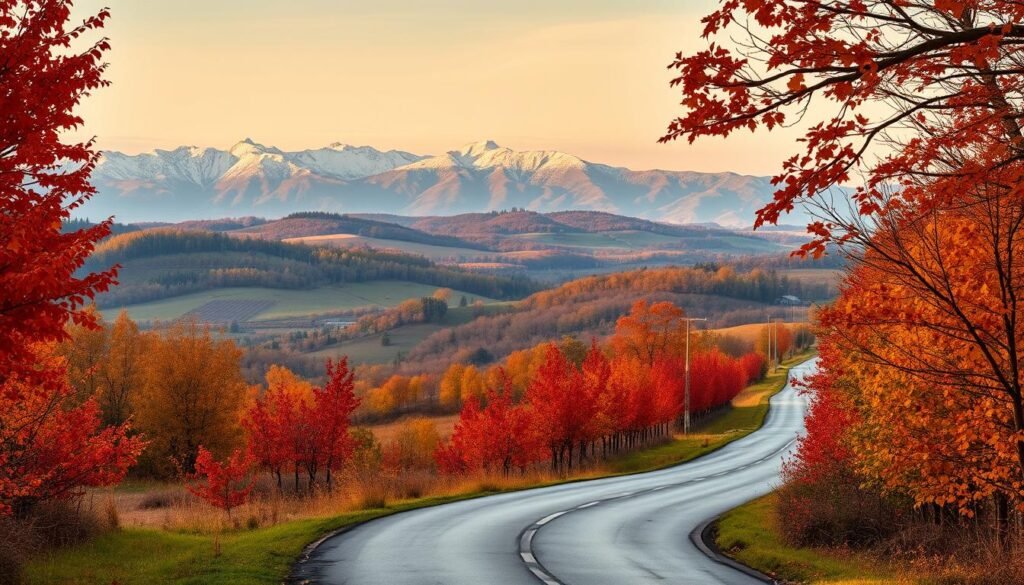
When leaves turn and the crowds thin, Europe shows a softer, more human side that I plan my trips around.
Better weather, fewer tourists, lower prices: real shoulder-season perks
Fall (September–November) is the season I prefer. Days are still mild, but mornings and nights call for layers. Lines shrink compared with summer, and hotels often drop rates.
The headline perk is balance: enough daylight for a full day of sights and city walks, but coolness that makes exploring comfortable any time.
Festivals to plan around: Oktoberfest, harvests, truffles, and wine time
I check best festival dates before booking. Oktoberfest in Munich is a big annual draw, and harvest weekends and truffle fairs—especially in Tuscany—bring lively menus and markets.
“Late October into early November often offers the best deals and the thinnest crowds.”
Smart packing and timing: layers, shorter hours, and late-October sweet spots
Pack layers: a light jacket, scarf, and a tee for midday warmth. Many attractions have shorter hours outside peak season, so I book major sights early in the day and keep afternoons flexible.
If you want the most value for your time, aim for late October into early November. Fall foliage and harvest menus make evenings and night photos especially rewarding.
- Fall is my favorite season to visit europe: milder weather, smaller lines, and more value than summer.
- Plan around festivals, pack for layers, and sequence big sights early in the day.
- This is the way I get the most out of a trip without fighting crowds.
How I plan the perfect day: trains, day trips, cafes, and golden-hour photos
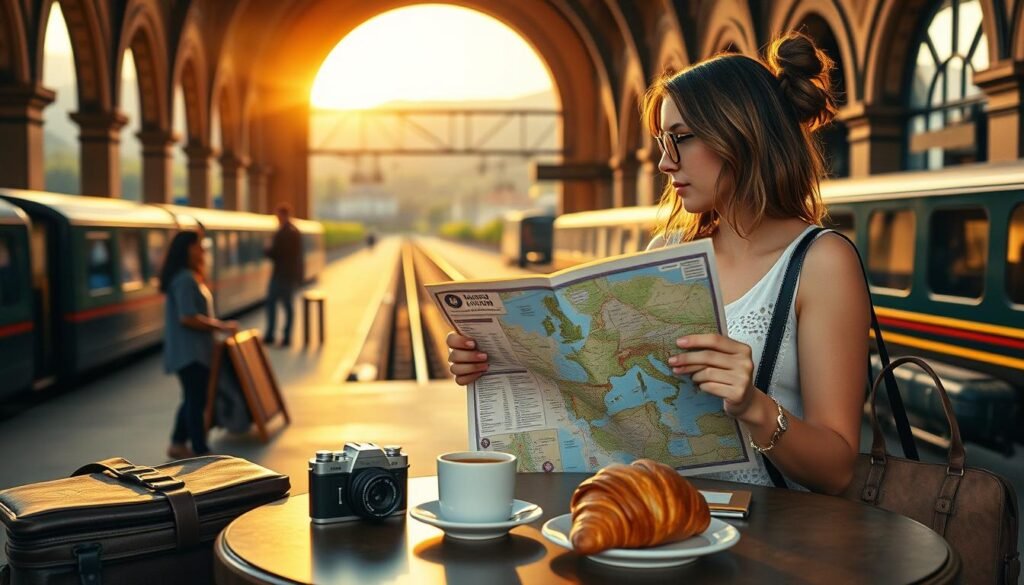
I design each day around a single unmissable moment and then build gentle pockets of time around it. That anchor might be a museum, a market, or a viewpoint at dusk.
Travel by train: easy day trips, flexible hours, and scenic routes
Trains make logistics part of the fun. Short hops—like Nuremberg to Munich under an hour—turn a festival into a simple day trip.
I pick routes that follow rivers or coasts and choose seats for views. Train travel lets me add scenery without stress.
Live like a local: cafes, markets, evening strolls, and neighborhood finds
I block the first two hours for a major sight while lines are low, then wander. I highly recommend bookmarking a market—Ljubljana’s Central Market is one I return to.
Ask locals for a coffee stand or a quiet square; their tips change the trip.
Photography flow: early mornings, blue-hour nights, and crowd-free ways
Early mornings buy space for photos—Venice at dawn is magical. I check best viewpoints and bridges so I arrive as lights come on.
“Anchor, wander, refuel, viewpoint, and a slow evening walk close the day.”
| Step | When | Why |
|---|---|---|
| Anchor a sight | First two hours | Low lines, high energy |
| Wander & refuel | Midday | Markets and cafes reset time |
| Viewpoint & blue hour | Evening | Lights, photos, slow close |
Conclusion
Pick two city anchors and one slow coastal or mountain stop to give your travel rhythm a gentle pulse.
From Paris and Venice to Dublin and Ljubljana, these european cities offer a mix of big sights and quiet corners that reward real time on the ground.
Fall is a season I aim for: thinner crowds, lower rates, and festivals that add local flavor. Add Strasbourg or Normandy for cross-border charm, and tuck a hidden gem—Belgrade, Kaszuby, or Ithaca—into a second visit.
Build your own list from this guide: two cities, a town, and one natural place. Leave space for markets, simple food, and short tours—those small things become the stories people ask about years later.


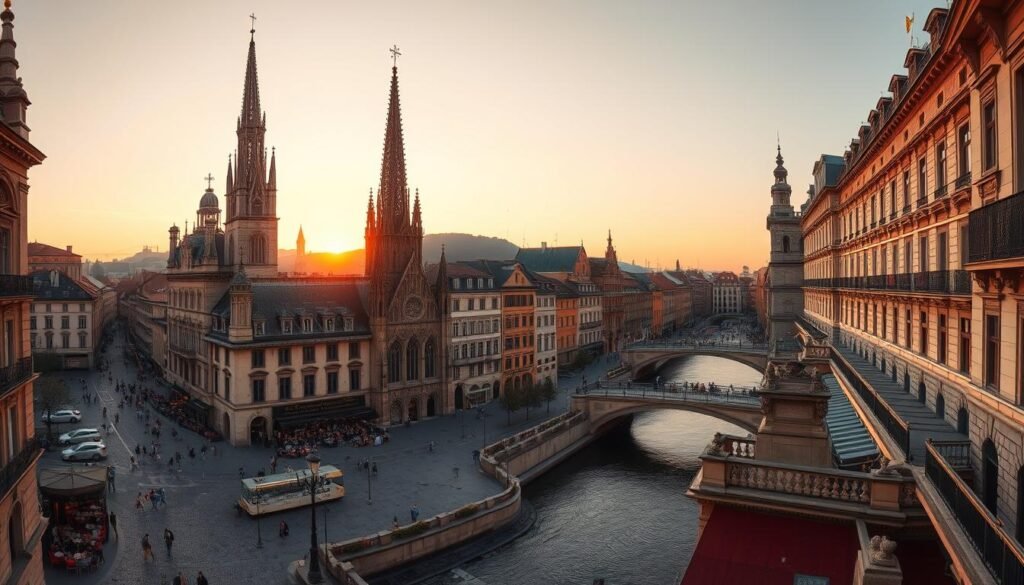



















One Response